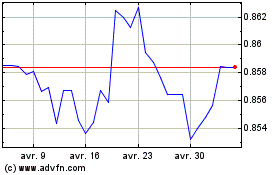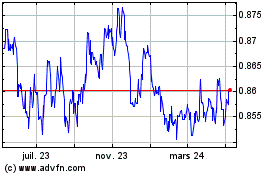Euro Recovers As Eurozone Inflation Confirmed At 4-month
18 Septembre 2017 - 8:18AM
RTTF2
The euro recouped its early losses against its key counterparts
in the European session on Monday, after data showed that Eurozone
inflation climbed to a four-month high in August, as initially
estimated.
Final data from Eurostat showed that consumer prices advanced
1.5 percent year-on-year in August, faster than the 1.3 percent
increase seen in July. This was the highest since April and in line
with the estimate published on August 31.
Nonetheless, inflation continues to stay well below the European
Central Bank's target of 'below, but close to 2 percent'.
On a monthly basis, consumer prices rose 0.3 percent in
August.
Further underpinning the currency was dovish comments by the ECB
Chief Economist and Executive Board member Peter Praet, who said in
an interview over the weekend that substantial stimulus is still
needed to ensure price stability target.
"This autumn we will decide on our policy next year," he
added.
Risk sentiment prevailed on easing geopolitical tensions and as
S&P Global Ratings raised Portugal's credit rating to
investment grade with a stable outlook, helping spur a rally in
euro-area peripheral bonds.
Investors await the crucial Fed meeting on Tuesday and Wednesday
for clues to the likelihood of a rate hike in December.
The single currency climbed against its major rivals in the
Asian session, with the exception of the pound.
The euro that edged down to 1.1915 against the greenback at 3:20
am ET bounced off to 1.1954. The pair ended last week's deals at
1.1919. The next possible resistance for the euro-greenback pair is
seen around the 1.23 region.
The single currency recovered to 133.07 against the yen, heading
to pierce its early 1-1/2-year high of 133.11. On the upside,
136.00 is possibly seen as the next resistance for the euro-yen
pair.
The euro, having fallen to a 2-month low of 0.8779 against the
pound at 2:30 am ET, reversed direction and climbed to 0.8830. If
the euro-pound pair extends gain, 0.90 is likely seen as its next
resistance level.
Data from property tracking website Rightmove showed that U.K.
house prices fell 1.2 percent on month in September
That follows the 0.9 percent decline in August, and it marks the
third monthly drop in four months.
The euro recovered to 1.4920 against the aussie, 1.4580 against
the loonie and 1.6355 against the kiwi, from its early lows of
1.4872 and 1.4513, and near a 4-week low of 1.6270, respectively.
The euro is poised to locate resistance around 1.51 against the
aussie, 1.48 against the loonie and 1.65 against the kiwi.
On the flip side, the 19-nation currency eased to 1.1451 against
the Swiss franc, from a high of 1.1485 hit at 2:45 am ET. If the
euro-franc pair extends drop, 1.135 is possibly seen as its next
support level.
Looking ahead, U.S. NAHB housing market index for September is
slated for release in the New York session.
At 10:30 am ET, ECB Board member Sabine Lautenschlager will
participate in Panel II "Policy challenges in the banking sector"
at conference "Supervisory policy implementation in the current
macro-financial environment: a cross-sectoral journey," organised
by BIS in Basel, Switzerland.
At 11:00 am ET, Bank of England Governor Mark Carney gives a
lecture at the International Monetary Fund (IMF) in Washington
D.C.
At 2:15 pm ET, Bank of Canada Deputy Governor Timothy Lane is
expected to speak at the Saskatoon Regional Economic Development
Authority in Saskatchewan, Canada.
Euro vs Sterling (FX:EURGBP)
Graphique Historique de la Devise
De Mar 2024 à Avr 2024

Euro vs Sterling (FX:EURGBP)
Graphique Historique de la Devise
De Avr 2023 à Avr 2024
